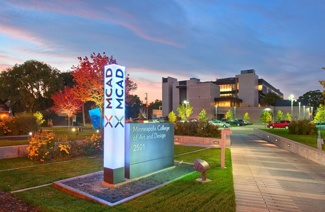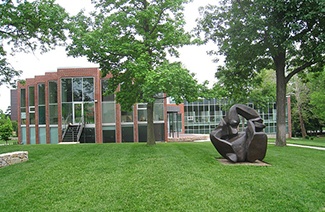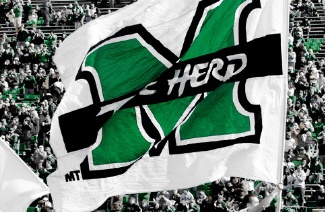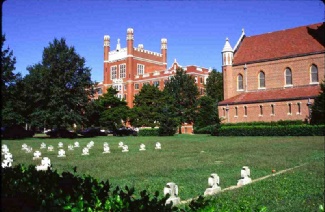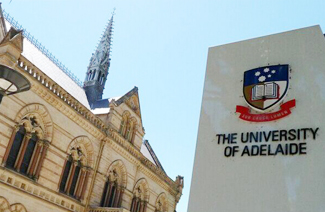2016年4月23日独家资料下载【四科汇总】,大家可以点击获取下载下来进行最后的冲刺,预祝考生取得好成绩。
L1:是讲mini肖像的,当时很受女性艺术家的追捧,就是画人像当卡片。好像重点是为了讲女性艺术家地位的变革。讲了AP这个人,说她最早的肖像是很典型的女性的保守特征(用了她姐姐的例子来说明),但是后来她冲破了传统,显示了女性professional的地位。
L2:讲大气中氧气含量的变化,海洋生物光合作用,氧气增加;生物死后埋在海底,碳减少,氧气也增加。有道题是关于氮气和氧气的比较,氧气更容易和其他物质结合。
L3:说的是营销手段。一般消费者购买东西会经过认知、调研、比较、最后购买等
5个步骤step.但是后来研究表明还有一种叫冲动消费impulse purchase.然后学生说了自己买果汁的经验,在结账的时候看到冰饮料,即使自己不想买,但是触摸到了以后就想买了,这种诱导方式叫做POP即兴购买。然后又说了食品业里面也有这种诱导方式,比如去吃汉堡,人家会问你要不要薯条,这样人们就冲动消费了。然后说食品公司还会调查大家的冲动消费习惯,比如在电影院吃爆米花,看完电影后会收集大家吃完的爆米花,看看还剩下多少,来决定以后在袋子里放多少爆米花。(问题有为什么男生会buy the juice?文中为什么提到汉堡?男生对于教授的讲述持什么观点?)
L4:海洋生物学。讲越来越多的artificial reef在被建造,这是因为人工reef的好处,越rough越好,hole越多越好,增加了生物的多样性biodiversity。这是因为有些小动物能将hole当做自己的inhabitant place,而大型海洋动物喜欢rough的环境,rough的环境能够方面他们栖息。
有个fungus能让美洲蝙蝠染上一种病,导致大量死亡,阅读给了3个建议来保护蝙蝠
(1)禁止人到洞穴参观,因为人的衣服上可能会沾上fungus,导致fungus从一个洞传到另一个洞
(2)研究欧洲一种能抵抗这种fungus的蝙蝠
(3)对洞穴加热
听力:(1)禁止人没用,蝙蝠才是fungus的主要传播源,即使没人去的洞穴,也有FUNGUS
(2)欧洲这种蝙蝠是花了好长时间才进化来的(biological adaptation),研究者需要花费几十年的时间来研究这种欧洲蝙蝠,但美洲的蝙蝠可能在tens of years就会全死光。
(3)加热make things worse。虽然HEATING能抑制FUNGUS,但也会让蝙蝠不能sleep。蝙蝠会觉得是夏天,wake up and starve.
综合口语
T3.阅读说学校要取消 healthy center,因为附近就有医院,不会影响学生。女孩反对说最的离校也要15 分钟车程,太远而且学生大多得的都是些小病比如流感、发烧外伤之类用不着去医院,有时候医院还不给看。
T4. 哲学的话题。人总是觉得自己认为的是对的,至少是 more common 的。听力否定,说有人做了个实验,让每个受试者选择是喜欢在安静的还是吵闹的环境,或是选择坐在椅子上听还是站起来说话。然后问这个人,觉得别人是否会和自己选择的一样。结论是不是,因为大部分人认为别人会反对自己的意见,人不会在所有方面都是对的。
T5.一个学生遇到 time conflict, 又要去 career fair 又要去打工,那个女的说,你可以请 coworker 帮忙,但是男的说他不想,因为 boss 很 nice 不想惹麻烦。后来那女的又说,你可以先去几分钟再去打工,可以先接触那些公司,之后再慢慢跟人家联系,那个男的说万一先去的没有他中意的公司呢?
T6.婴儿和他们的抚养者的感情(emotional development)是通过什么建立起来的。以前认为是通过 feed, 家长给孩子食物,孩子就对家长更依赖,他们之间建立了 bond。后来提出了不是这么回事,而是 warm and loving touch 是孩子 love家长。做了个实验 baby monkeys, two substitute mother made of metal wire, 但是有一个 mother 包上了毛绒外壳。小猴分两组,一组是金属妈妈喂,另一组是毛绒妈妈喂,平时不是吃饭时间小猴可以随便 touch 两个妈妈,发现不管被谁喂,所有小猴都喜欢毛绒妈妈,所以证明了 touching 是感情的。题目让叙述实验怎么证实这个说法的。
独立口语:T1.Describe a day that you enjoyed the most or was the most special to you. Include reasons and details to support your response.
T2.Some people always try the food that they have never tasted before while others don't. Which do you prefer?
2016年4月23日托福机经资料内容
2016年4月23日托福机经中阅读资料如下:
NASA Confirms Evidence That Liquid Water Flows on Today’s Mars(2.15.9.28)
New findings from NASA's Mars Reconnaissance Orbiter (MRO) provide the strongest evidence yet that liquid water flows intermittently on present-day Mars.
Using an imaging spectrometer on MRO, researchers detected signatures of hydrated minerals on slopes where mysterious streaks are seen on the Red Planet. These darkish streaks appear to ebb and flow over time. They darken and appear to flow down steep slopes during warm seasons, and then fade in cooler seasons. They appear in several locations on Mars when temperatures are above minus 10 degrees Fahrenheit (minus 23 Celsius), and disappear at colder times.
“Our quest on Mars has been to ‘follow the water,’ in our search for life in the universe, and now we have convincing science that validates what we’ve long suspected,” said John Grunsfeld, astronaut and associate administrator of NASA’s Science Mission Directorate in Washington. “This is a significant development, as it appears to confirm that water -- albeit briny -- is flowing today on the surface of Mars.”
These downhill flows, known as recurring slope lineae (RSL), often have been described as possibly related to liquid water. The new findings of hydrated salts on the slopes point to what that relationship may be to these dark features. The hydrated salts would lower the freezing point of a liquid brine, just as salt on roads here on Earth causes ice and snow to melt more rapidly. Scientists say it’s likely a shallow subsurface flow, with enough water wicking to the surface to explain the darkening.
"We found the hydrated salts only when the seasonal features were widest, which suggests that either the dark streaks themselves or a process that forms them is the source of the hydration. In either case, the detection of hydrated salts on these slopes means that water plays a vital role in the formation of these streaks," said Lujendra Ojha of the Georgia Institute of Technology (Georgia Tech) in Atlanta, lead author of a report on these findings published Sept. 28 by Nature Geoscience.
Ojha first noticed these puzzling features as a University of Arizona undergraduate student in 2010, using images from the MRO's High Resolution Imaging Science Experiment (HiRISE). HiRISE observations now have documented RSL at dozens of sites on Mars. The new study pairs HiRISE observations with mineral mapping by MRO’s Compact Reconnaissance Imaging Spectrometer for Mars (CRISM).
The spectrometer observations show signatures of hydrated salts at multiple RSL locations, but only when the dark features were relatively wide. When the researchers looked at the same locations and RSL weren't as extensive, they detected no hydrated salt.
Ojha and his co-authors interpret the spectral signatures as caused by hydrated minerals called perchlorates. The hydrated salts most consistent with the chemical signatures are likely a mixture of magnesium perchlorate, magnesium chlorate and sodium perchlorate. Some perchlorates have been shown to keep liquids from freezing even when conditions are as cold as minus 94 degrees Fahrenheit (minus 70 Celsius). On Earth, naturally produced perchlorates are concentrated in deserts, and some types of perchlorates can be used as rocket propellant.
Perchlorates have previously been seen on Mars. NASA's Phoenix lander and Curiosity rover both found them in the planet's soil, and some scientists believe that the Viking missions in the 1970s measured signatures of these salts. However, this study of RSL detected perchlorates, now in hydrated form, in different areas than those explored by the landers. This also is the first time perchlorates have been identified from orbit.
MRO has been examining Mars since 2006 with its six science instruments.
"The ability of MRO to observe for multiple Mars years with a payload able to see the fine detail of these features has enabled findings such as these: first identifying the puzzling seasonal streaks and now making a big step towards explaining what they are," said Rich Zurek, MRO project scientist at NASA's Jet Propulsion Laboratory (JPL) in Pasadena, California.
For Ojha, the new findings are more proof that the mysterious lines he first saw darkening Martian slopes five years ago are, indeed, present-day water.
"When most people talk about water on Mars, they're usually talking about ancient water or frozen water," he said. "Now we know there’s more to the story. This is the first spectral detection that unambiguously supports our liquid water-formation hypotheses for RSL."
The discovery is the latest of many breakthroughs by NASA’s Mars missions.
“It took multiple spacecraft over several years to solve this mystery, and now we know there is liquid water on the surface of this cold, desert planet,” said Michael Meyer, lead scientist for NASA’s Mars Exploration Program at the agency’s headquarters in Washington. “It seems that the more we study Mars, the more we learn how life could be supported and where there are resources to support life in the future.”
以上为大家整理的2016年4月23日托福机经资料,大家可以下载下来进行掌握。
